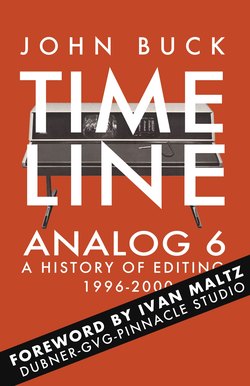Читать книгу Timeline Analog 6 - John Buck - Страница 10
MEDIA 100 AND AVID
ОглавлениеAvid cut back on research and development, eliminated 100 jobs, moved Curt Rawley aside and appointed Daniel Keshian as company president. While many queried the company’s focus on editing, it had 50 workstations on display at the NAB conference and a host of substantial announcements.
Mike Bennett wrote:
Even with downsizing and management reorganization, Avid has had numerous major product announcements. Even Apple was included with Avid products such as Media Composer, which is now available for the Power Mac
It released Media Composer 6.1 to fight off the challenge from Media 100’s xs system. It had finally moved from using multiple NuBus cards on every system to a single PCI board.
Gartner's Bill Caffery viewed Avid’s move to PCI.
Pumping that amount of bits through NuBus is like driving a golf ball through a garden hose. You can do it, but why would you want to?
For a price between $30,000 and $100,00 Version 6.1 gave editors support for resolutions of 720 by 486 pixels, the ability to import QuickTime movies with alpha channels and a ‘rubber band’ UI for adjusting audio levels. Avid also demonstrated two systems that marked opposite ends of the editing world.
It launched MCXpress for $15,000 and the $250,000 Media Spectrum was shown in prototype.
MCXpress was set to replace the old NuBus Media Suite Pro. It could be used to edit rushes and master back to videotape at close to broadcast quality without ever needing to leave the system. It could also be operated as an offline system that fed its timeline sequences to the more advanced Media Composer to add real-time effects.
Avid’s new system trumped Media 100 because it ran on Power Macintosh or Windows NT and a client could buy the software alone. With the market now awash with reliable plug-in video cards and editors savvy enough to build their own suites Avid was taking its first steps toward away from turnkey devices.
Clyde Tressler and Bob Lamm tested the Avid MCXpress.
We found it to be very convenient and capable. Digitizing and logging are very quick and easy to do, digitized media can be sorted in various folders, you can even storyboard the production in the bin, then drag all the clips onto the timeline at once.
Avid, D-Vision and ImMIX had set new benchmarks. Editors using Media 100 demanded special effects tools ‘just like ImMIX’ while others wanted a PC version,'like Avid'.
John Molinari’s team was already overstretched to catch up to ImMIX so he turned to the only independent industry expert in delivering board based effects, Pinnacle Systems.
Engineers from both companies worked to merge Pinnacle’s Genie tech with Media 100's Vincent 601 engine.
Molinari also began discussions with Macromedia to be the prime hardware supplier for KeyGrip.
We knew Randy and Tim from Adobe and as far as we were concerned they had just moved their operation to a different address. So I looked at their new product.
However Molinari’s interest bothered Media 100‘s Software Group head Ralf Berger:
I recall a meeting we had in San Francisco with Randy Ubillos from Macromedia and even though there wasn't much talk about specific product features, John Molinari was just so enthusiastic, so effusive about the KeyGrip concept.
When it became obvious that John wanted to pursue the relationship with Macromedia and launch a PC product using Media 100 hardware and the KeyGrip software, we became pretty disillusioned. It really undermined everything we were trying to do at the company.
Media 100 software engineer David McCarthy reflects:
It's hard to fault the move (by Media 100) to PCs because Apple's survival was not a sure thing at that time. And even then, Apple was prone to making hardware changes in the Mac that were very difficult for a hardware company to keep pace with.
However, the customer base got the impression that M100 was abandoning the platform entirely (and really, they were right, except that the Mac product kept generating revenue and nothing else did, so the company was forced to keep it alive, grudgingly.)
A bet-the-company move on Apple hardware was at least as risky as its later moves (844), but now we know it might have been a better move.
